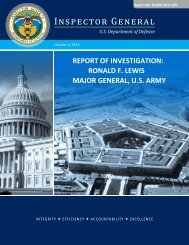Command Red Team
2gWzzvB
2gWzzvB
You also want an ePaper? Increase the reach of your titles
YUMPU automatically turns print PDFs into web optimized ePapers that Google loves.
<strong>Red</strong> <strong>Team</strong> Challenges<br />
assumptions, and efficiently focus their efforts on assigned tasks while excluding<br />
seemingly-irrelevant issues. These traits usually indicate that a working group has a<br />
common understanding of its goals and the methods it intends to use to achieve them.<br />
However, efficient decision-making processes may not always deal well with unusual<br />
problems or novel conditions, where a working group’s unstated assumptions do not<br />
correspond to the situation at hand.<br />
e. Common forms of institutional bias and influence are summarized as follows.<br />
The red team must be integrated into the working groups and simultaneously maintain<br />
sufficient intellectual and institutional independence to be able to see and help counter<br />
these common forms of institutional bias and influence.<br />
(1) Groupthink (see Figure III-1). Cohesive working groups composed of<br />
like-minded individuals may promote solidarity, consensus, and professionalism, but they<br />
may achieve these benefits at the expense of not fully examining assumptions or<br />
considering alternatives. Such organizations can make decisions quickly and efficiently,<br />
but their conclusions and solutions may not always be optimal, especially in novel<br />
situations or when dealing with paradigm shifts. Individuals who try to get the group to<br />
reexamine its stance on an issue may be marginalized, especially if they are seen as<br />
outside interlopers who have not earned membership in the group. The red team can help<br />
counter groupthink by joining the group early and sensitizing the group to its role, and by<br />
contributing to the group as it acquires its sense of identity. <strong>Red</strong> teams can support<br />
people who raise contentious issues and minority views that would otherwise be<br />
marginalized or ignored by the group. This will slow down the process, allowing more<br />
time to better think through and evaluate the problem, rather than reaching a premature<br />
consensus. The group will be more likely to accept input from an accepted group<br />
member, and any red team input will more likely be considered if the group has been<br />
attuned to the team’s role.<br />
CHARACTERISTICS OF GROUPTHINK<br />
-Illusion of unanimity.<br />
-Self-appointed “mindguards” who protect the group from conflicting<br />
information.<br />
-Perception of infallibility, promoting excessive optimism and risk<br />
taking.<br />
-Unquestioned belief in need for group to continue, despite changing<br />
conditions; tendency to rationalize away contrary information.<br />
-Stereotyped views of the adversary and other relevant actors.<br />
-Pressure for conformity regarding the group’s assumptions,<br />
decisions, and processes.<br />
-Self-censorship of deviations from consensus.<br />
Figure III-1. Characteristics of Groupthink<br />
(2) Tribal Think. Some working groups include action officers whose primary<br />
task is to protect or advance their directorate’s position during the group’s deliberations.<br />
This can help improve the group’s work by ensuring the approved positions of all<br />
III-7



